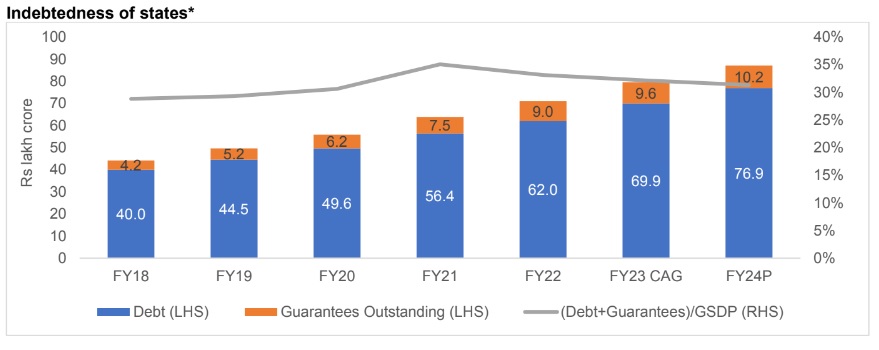To be sure, the 50-year interest-free loans for Rs 1.3 lakh crore from the centre to states will help meet part of the capital outlay and catalyse investments

FinTech BizNews Service
Mumbai, December 4, 2023: The aggregate indebtedness of states — measured as debt to gross state domestic product (GSDP) — is expected to remain high at 31-32% this fiscal, with overall borrowings, including guarantees, likely to rise by 9% to over Rs 87 lakh crore, according to a report by CRISIL Ratings. States analysed by CRISIL Ratings are: Maharashtra, Gujarat, Karnataka, Tamil Nadu, Uttar Pradesh, Telangana, Rajasthan, West Bengal, Madhya Pradesh, Andhra Pradesh, Kerala, Odisha, Punjab, Bihar, Chhattisgarh, Haryana, Jharkhand and Goa.
States are borrowing more to expand capital outlays, besides meeting high committed revenue expenditure (related to salaries, pension and interest costs). This, along with modest single-digit revenue growth, will keep debt high.
Pre-pandemic, the debt/GSDP ratio was at 28-29%.
That said, the aggregate gross fiscal deficit (GFD) as a ratio of GSDP is expected to remain at 2.5%, within the Fiscal Responsibility and Budget Management (FRBM) Act norm of 3%. A CRISIL Ratings study of the top 18 states, accounting for 90% of the aggregate GSDP, indicates as much.
After a small revenue surplus in fiscal 2022, states slipped into deficit in fiscal 2023, as overall revenues grew at a modest 8% while revenue expenditure rose faster at 11% on-year.
This fiscal, overall revenue is expected to rise 6-8%, supported by goods and services tax (GST) collections, devolutions from the centre, and taxes and duties on liquor sales. On the other hand, revenue expenditure is set to increase 8-10%, driven by higher committed expenditure, and increasing social welfare and public health related expenses (combined, 65% of the total revenue expenditure).
Says Anuj Sethi, Senior Director, CRISIL Ratings, “The revenue deficit will inch up to 0.5% of GSDP this fiscal from 0.3% last fiscal. This, coupled with the 18-20%3 on-year increase in capital outlays of states (~2.3% of GSDP) on key infrastructure segments such as water supply & sanitation, urban development, roads and irrigation will necessitate higher borrowings this fiscal, too.”
To be sure, the 50-year interest-free loans for Rs 1.3 lakh crore from the centre to states will help meet part of the capital outlay and catalyse investments. Moreover, this loan is not included in the borrowing limit of 3% of GSDP for states this fiscal.
Says Aditya Jhaver, Director, CRISIL Ratings, “Overall balance sheet borrowings of states and off-budget borrowings such as guarantees to the power sector and irrigation entities, are likely to go up by Rs 7.5 lakh crore this fiscal and cross Rs 87 lakh crore, keeping States’ indebtedness high at 31-32%, similar to fiscal 2023. Already, borrowings through state development loans (SDLs, comprising 65% of the overall borrowings for states) rose 28%5 on-year between April and November 2023.”
Any slowdown in economic activity could hurt GSDP growth and pose a downside risk to CRISIL Ratings’ estimates.
On the other hand, better-than-expected tax buoyancy or support from the centre in the form of higher grants could provide further liquidity buffer to states.